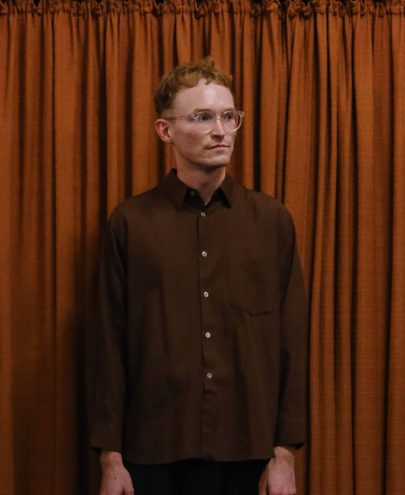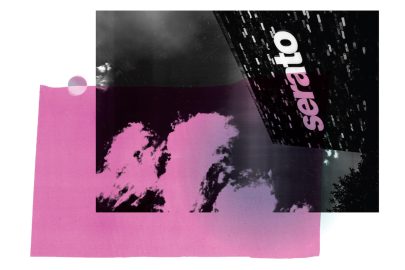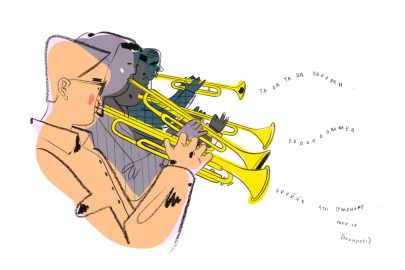Apr 15, 2015 Music
The Basement is a pretty small place; you have to pass within a few feet of the sleepers to get to your seats, and there are no seats more than a few metres from the stage. The intimacy of it, even given the show’s name and description – Dreams, “A miniature orchestra in a Victorian bedchamber” – is startling.
This was my first Blackbird show. I wanted to try one, because I’d heard they bring a non-traditional approach to classical music. The programme text for Dreams includes this: “The Blackbird Ensemble shows are born out of a desire to play music that is rarely performed, and to change the traditional classical music performance context. The Blackbird Ensemble blends orchestral music techniques with contemporary music and visuals to create an intriguing, provocative and powerful experience”.
Promising. When the audience was mostly seated, but still milling and settling, someone I at first took to be just another punter stepped out into the performance area – I was in the front row and I have long legs; I assumed she was stepping around me. But she veered off close to the largest bed and tugged a couple of times on the sheets, as if straightening them. As she walked on, the violinist on the bed sat up slowly, as if in her sleep, and began playing a repeating five note figure over a double-stopped peddle note.
Other players stirred and began to join in, all of them playing the way you might go about getting breakfast in the very early morning: drowsy, not making eye contact, loose-limbed and yawny. The guy lying next to the violinist picked up a soft-headed drum stick and banged out a couple of notes on the bass drum, which still had someone lying asleep on it. It took several tries to wake him. All these drum notes fell perfectly timed into the evolving music, but they also had the very plausible look of someone still half-asleep gently nudging someone who needs to get out of bed and get moving.
This was magical. After a while the music turned into a fragment of Stravinsky’s Firebird, nicely orchestrated for a very non-standard ensemble (at this point there were seven players onstage, ranging from string players to drum kit, sax, trombone and electric guitar). The music fell apart into violent chaos, and reassembled itself as Radiohead’s “How To Disappear Completely”, sung by Mikey Brown, who wandered onto the stage – eyes open, but a plausible somnabulist – as he sang.
More songs followed, and more songs, and more, some featuring Brown, some Jessie Cassin (who had an even better entrance), some both. There were a few more fragmentary instrumental interludes, but it quite quickly became clear that the show is overwhelmingly a set of contemporary songs, all themed around ideas of dreaming or sleeping.
You know that moment where you realise that your substantial good will towards a show – that wave of happy I’ll-go-where-you-take-me openness that’s so much fun to ride – has begun to ebb? It’s not a great moment. It arrived for me five or six songs into the set. Disappointed expectations were definitely a factor – I’m a classical boy with a fair degree of frustration with fusty classical performance norms, and I was hoping, bluntly, to hear more music I recognised – but for all that, I was willing to go with whatever Blackbird gave me.
My larger issue was with texture and volume. Musical director Claire Cowan uses a wide range of instruments in this show, many more than her number of performers, and in a wide range of combinations. What she doesn’t vary much is the total number of instruments playing at any one time: nearly all the numbers use all the available players and one or both of the vocalists, and they’re all amplified. The texture of the music was nearly always thick and full, and did I mention that The Basement is a very small venue?
If you graphed my happiness over the ninety minutes of this show, it would start out as a plunging wave-form, but then it would rise again. The failure to go small and muted for more of the songs seems a very obvious lost opportunity, both in general performance terms – loud punches harder when it follows quiet, this is not rocket science – and in terms of the dream-theme. But the staging remained very effective throughout. There’s something at once charming and powerfully defamiliarising about a concert where all the performers are dressed for bed. And the songs flowed beautifully into one another – there were no breaks in the show’s ninety minutes – and many of them, especially the ones towards the end, notably Fleet Foxes “Grown Ocean” and Gillian Welch’s “I Dream a Highway”, I loved.
This is not quite the don’t-you-dare-miss-it show I was hoping for. But it’s pretty rewarding. I want to hear more from this group.
The Basement, to April 18. iticket.co.nz
Photo by Striped Trees Productions.





